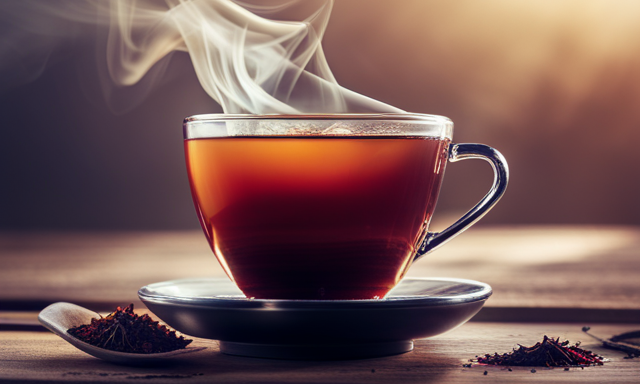I have always been fascinated by the power of nature to provide us with incredible ingredients that offer both flavor and health benefits. One such ingredient that has recently caught my attention is rooibos leaves.
Picture this: a warm summer afternoon, a gentle breeze rustling through the leaves, and a cup of steaming rooibos tea in your hand. As you take a sip, you can’t help but notice the earthy and slightly sweet taste that dances on your tongue.
Rooibos leaves, also known as ‘red bush,’ originate from the Cederberg region of South Africa. They have been enjoyed for centuries by the local people for their medicinal properties and unique flavor.
What sets rooibos leaves apart is their rich nutritional profile, packed with antioxidants, minerals, and vitamins. These powerful compounds contribute to a range of health benefits, from boosting your immune system to promoting healthy skin.
In this article, we will delve into the origins of rooibos leaves, explore their nutritional value, uncover their health benefits, and discover various ways to incorporate them into your lifestyle. So sit back, relax, and let’s dive into the world of rooibos leaves.
Key Takeaways
- Rooibos leaves have been used in traditional medicine for centuries and have various health benefits, including easing digestive issues, relieving stress, and supporting a healthy digestive system.
- Rooibos leaves have potential anti-inflammatory properties and can reduce inflammation in the body, alleviate joint pain and swelling, and inhibit the production of pro-inflammatory molecules.
- Rooibos leaves are beneficial for skin care as they are rich in antioxidants, reduce signs of aging, soothe irritated skin, and enhance the complexion for a more radiant look.
- Rooibos leaves can be incorporated into culinary recipes to add rich flavors and aromatic essences, and they pair well with a range of flavors. They can be infused into desserts or used in marinades, sauces, or rubs for meat and vegetables.
Origins of Rooibos Leaves
Rooibos leaves, also known as ‘red bush’ leaves, have a fascinating origin story. These leaves come from the Aspalathus linearis plant, which is native to the Cederberg region of South Africa. The plant has been used for centuries by the indigenous Khoisan people, who recognized its medicinal properties and brewed it into a flavorful tea. Over time, the popularity of rooibos leaves spread beyond the local communities and gained recognition worldwide for its unique taste and numerous health benefits.
Speaking of health benefits, rooibos leaves are packed with antioxidants, such as aspalathin and nothofagin, which help protect the body against free radicals and reduce inflammation. They are also naturally caffeine-free, making it a great alternative for those looking to cut down on caffeine consumption. Additionally, rooibos leaves have been linked to improved heart health, digestion, and even skin conditions.
Moving on to the nutritional profile of rooibos leaves…
Nutritional Profile of Rooibos Leaves
Packed with an astonishing array of nutrients, these tea leaves are a health-conscious individual’s dream come true. Rooibos leaves are not only delicious but also offer numerous nutritional benefits. They are rich in antioxidants, including aspalathin and nothofagin, which help protect the body against oxidative stress and inflammation. Additionally, rooibos leaves contain essential minerals like calcium, magnesium, and potassium, which support bone health and promote proper muscle function.
To provide a comprehensive overview of the nutritional profile of rooibos leaves, here is a table showcasing some key nutrients found in a typical serving:
| Nutrient | Amount per Serving |
|---|---|
| Antioxidants | High |
| Calcium | 9 mg |
| Magnesium | 2 mg |
| Potassium | 22 mg |
These values may vary slightly depending on cultivation methods and processing. With such a remarkable nutritional profile, it’s no wonder that rooibos leaves have gained popularity among health enthusiasts. They offer a multitude of health benefits, which we will explore in the next section.
Health Benefits of Rooibos Leaves
Indulge in the health benefits of rooibos tea, and you’ll be amazed at the positive impact it can have on your well-being. Research studies have shown promising results regarding the effectiveness of rooibos leaves in managing diabetes. The antioxidants found in rooibos leaves help regulate blood sugar levels and improve insulin resistance, making it a valuable addition to a diabetic’s diet.
Additionally, rooibos leaves play a vital role in promoting weight loss and improving metabolism. They contain compounds that help suppress appetite and increase fat oxidation, leading to a more efficient calorie burn. Incorporating rooibos tea into your daily routine can aid in achieving and maintaining a healthy weight.
Now that we have explored the health benefits, let’s move on to the next section about preparation and brewing methods.
Preparation and Brewing Methods
When it comes to preparing and brewing rooibos tea, there are a few key points to consider:
-
Loose leaf vs. tea bags: Using loose leaf rooibos tea provides a more flavorful and aromatic experience compared to tea bags.
-
Water temperature: It is important to use water that is just below boiling point, around 200°F, to avoid scorching the delicate leaves.
-
Steeping time: Steeping rooibos tea for about 5-7 minutes allows the full range of health benefits and flavors to be extracted, resulting in a rich and satisfying cup of tea.
Loose leaf vs. tea bags
If you’re looking for convenience, loose leaf rooibos tea might seem like a hassle, but trust me, the flavor is worth the extra effort. While tea bags offer a quick and easy way to make a cup of tea, loose leaf rooibos provides a more authentic and robust taste.
The main advantage of loose leaf tea is that it allows the leaves to fully expand, releasing all their flavors and aromas. This results in a richer and more satisfying cup of tea.
Additionally, loose leaf rooibos contains more health benefits compared to tea bags. The leaves are less processed and retain more of their natural antioxidants and minerals.
So, even though it may require a bit more time and effort, choosing loose leaf rooibos is definitely worth it.
Now, let’s move on to the next section about water temperature and steeping time.
Water temperature and steeping time
When it comes to brewing rooibos tea, the water temperature and steeping time are crucial factors that can greatly impact the flavor and overall experience. Rooibos leaves are delicate and require a gentler touch compared to other types of tea.
To achieve the perfect cup, it is important to use water that is just below boiling, around 203°F (95°C). This temperature allows the leaves to release their full flavor without becoming bitter.
As for steeping time, rooibos tea typically requires a longer infusion period compared to other teas. A steeping time of 5-7 minutes is recommended to extract the rich flavors and aromas from the leaves.
By paying attention to the water temperature and steeping time, you can ensure a well-balanced and satisfying cup of rooibos tea that truly captures its unique taste and flavor profile.
[Transition: Now, let’s explore the taste and flavor profile of rooibos tea.]Taste and Flavor Profile
Indulge in the rich and distinctive taste of rooibos leaves, as they offer a delightfully smooth and naturally sweet flavor profile that will leave you craving for more. This unique herbal tea boasts a myriad of flavors that appeal to the senses, making it a popular choice among tea enthusiasts.
Here are three key aspects of rooibos leaves’ flavor profile and brewing methods:
-
Sweetness: Rooibos leaves have a natural sweetness that sets them apart from other teas. This sweetness is not overpowering but rather subtle, making it a perfect choice for those who prefer a gentle touch of sweetness in their tea.
-
Earthy undertones: Alongside its sweetness, rooibos also carries distinct earthy notes. These earthy undertones provide a grounding and comforting element to the tea, making it an ideal beverage for relaxation and unwinding.
-
Smooth texture: Rooibos leaves brew into a velvety and smooth beverage. The texture is akin to silk, creating a luxurious experience with every sip.
With its captivating flavor profile and versatile brewing methods, rooibos leaves have been treasured for centuries. They not only bring pleasure to our taste buds but also offer various health benefits in traditional medicine. Transitioning into the subsequent section, let’s explore the intriguing role of rooibos leaves in traditional medicine.
Rooibos Leaves in Traditional Medicine
In traditional medicine, rooibos leaves have been used as a remedy for various ailments. They have been known to be effective in treating digestive issues, relieving allergies, and soothing skin irritations.
Additionally, rooibos leaves are believed to possess potential anti-inflammatory properties, making them a valuable ingredient in natural remedies for inflammatory conditions such as arthritis and asthma.
Use as a remedy for various ailments
Rooibos leaves have long been used in traditional medicine for their remarkable benefits. They contain natural compounds that help to ease digestive issues such as constipation and indigestion. Additionally, rooibos leaves are known for their stress-relieving properties. They contain antioxidants that help to reduce stress and promote relaxation. So, not only will a cup of rooibos tea help to calm your mind, but it will also aid in supporting a healthy digestive system.
Transitioning into the next section, rooibos leaves also show potential anti-inflammatory properties.
Potential anti-inflammatory properties
Experience the soothing power of rooibos tea as it potentially helps to reduce inflammation, providing relief and comfort to your body.
Rooibos leaves are known for their potential anti-inflammatory properties, which have been studied for their various health benefits. Research suggests that rooibos tea may help to alleviate symptoms associated with inflammation, such as joint pain and swelling.
The anti-inflammatory compounds found in rooibos leaves, such as aspalathin and nothofagin, have been shown to inhibit the production of pro-inflammatory molecules in the body. By incorporating rooibos tea into your daily routine, you may be able to experience the potential relief it offers.
As we delve into the next section about rooibos leaves and skin care, we will explore how these leaves can benefit your skin as well.
Rooibos Leaves and Skin Care
Rooibos leaves have numerous beneficial properties for the skin. They are rich in antioxidants, which protect the skin from damage caused by free radicals and reduce signs of aging like wrinkles and fine lines. Rooibos leaves also have anti-inflammatory properties, soothing and calming irritated skin. Additionally, they contain alpha hydroxy acids that gently exfoliate the skin, promoting a smoother and more radiant complexion. To incorporate rooibos leaves into your skincare routine, try using products with rooibos extract or brew a cup of rooibos tea as a toner.
When considering sustainability and environmental impact, it’s important to ensure that rooibos leaves are harvested in a sustainable manner.
Sustainability and Environmental Impact
With a focus on sustainability, the sourcing and production methods of rooibos should be carefully considered to ensure minimal environmental impact. Sustainable farming practices play a crucial role in the cultivation of rooibos leaves. These practices include organic farming techniques, such as avoiding the use of synthetic pesticides and fertilizers, and promoting biodiversity on the farms. Additionally, eco-friendly packaging is essential to reduce waste and minimize the carbon footprint. Using recyclable or biodegradable materials for packaging can significantly contribute to a more sustainable rooibos industry. By implementing these measures, we can ensure that the production of rooibos leaves is both environmentally friendly and socially responsible. Transitioning into the subsequent section about ‘rooibos leaves in culinary applications,’ it is important to explore the versatility of this ingredient beyond skincare.
Rooibos Leaves in Culinary Applications
Indulge your taste buds with the rich flavors and aromatic essences that can be created when incorporating rooibos leaves into your culinary creations. Rooibos leaves offer a unique and delightful addition to various recipes, adding depth and complexity to both sweet and savory dishes.
Its earthy and slightly sweet taste pairs well with a range of flavors, making it a versatile ingredient in the kitchen. For a sweet treat, try infusing rooibos leaves into your favorite desserts like cakes, cookies, or ice cream. The warm and comforting flavors of rooibos can also be incorporated into savory dishes such as marinades, sauces, or rubs for meat and vegetables.
Experiment with different flavor pairings to discover the perfect combination that suits your palate. From desserts to main courses, rooibos leaves can elevate your culinary creations to new heights.
Transitioning to the next section, let’s explore how incorporating rooibos leaves into your lifestyle can bring about a multitude of benefits.
Conclusion: Incorporating Rooibos Leaves into Your Lifestyle
Incorporating rooibos into your lifestyle can lead to a multitude of benefits, such as improved sleep quality. Studies have shown that regular consumption of rooibos tea can help individuals fall asleep faster and experience a deeper sleep. Adding rooibos leaves to your diet can also provide other advantages.
Here are three benefits of incorporating rooibos leaves into your daily routine:
-
Boosted immune system: Rooibos leaves contain antioxidants that can strengthen the immune system and protect the body against various diseases.
-
Improved digestion: Rooibos leaves have been known to soothe the digestive system and alleviate digestive issues such as bloating and indigestion.
-
Enhanced skin health: The antioxidants in rooibos leaves can help combat free radicals, reducing signs of aging and promoting healthy, glowing skin.
By incorporating rooibos leaves into your diet, you can enjoy these benefits and improve your overall well-being.
Frequently Asked Questions
How long does it take for rooibos leaves to reach maturity before they can be harvested?
Rooibos leaves typically take around 18 months to reach maturity before they can be harvested. The harvest timing is crucial as it ensures that the leaves have developed the desired flavor and aroma profiles for the best quality tea.
Are there any potential side effects or risks associated with consuming rooibos leaves?
There are no known side effects or risks associated with consuming rooibos leaves. In fact, they have several potential health benefits, such as improving digestion and promoting heart health. It is recommended to have a daily intake of 2-3 cups of rooibos tea.
Can rooibos leaves be used in combination with other herbs or ingredients for enhanced health benefits?
Oh, let me tell you, using rooibos leaves in herbal tea blends is like adding a touch of magic to your cup. It’s a powerhouse ingredient that can enhance your overall well-being. Trust me, you’ll feel the difference.
Are there any specific storage requirements for preserving the freshness and quality of rooibos leaves?
To preserve the freshness and quality of rooibos leaves, it is important to store them in an airtight container away from light, heat, and moisture. This ensures that the leaves retain their health benefits and flavor for an extended period.
Is there a specific time of the day or season that is considered optimal for harvesting rooibos leaves to maximize their flavor and benefits?
The best time to harvest rooibos leaves is during the hot and dry summer season to maximize their flavor and benefits. This ensures that the leaves are at their peak in terms of taste and nutritional value.
Conclusion
In conclusion, incorporating Rooibos leaves into your lifestyle is an absolute game-changer. Trust me, once you experience the rich and earthy flavor, you’ll never go back.
Not only does it offer a plethora of health benefits, but its versatility in culinary applications is mind-blowing.
From soothing your skin to boosting your immune system, Rooibos leaves are a true powerhouse.
And let’s not forget about its sustainable and environmentally-friendly nature.
So go ahead, embrace the magic of Rooibos leaves and elevate your life to new heights. You won’t be disappointed.










